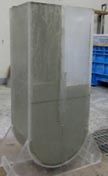Self-filling concrete using sea water and sea sand

- researcher's name
-
about researcher KIYOMIYA, Osamu Professor (retired)
- affiliation
- keyword
-
background
Regions where methods for transportation via land and sea routes are limited, represented by places such as isolated islands and desert areas, face consistently high procurement costs due to difficulties related to obtaining pure water, sand, and gravel in addition to high transportation costs.
summary
This project developed self-filling concrete using sea water as mixing water, sand as aggregate, and a new admixture that can provide these materials with superior fluidity and appropriate viscosity (A high-performance AE water reducing agent with a one-pack type thickener containing salt).
application/development
This technology can be used for the construction of structures that use materials with virtually no problems related to gravel corrosion (stainless steel, carbon fibers, etc.). It is possible to undertake construction using sand if salt water is available. It also makes it easy to do work in coastal areas.
predominance
Because the concrete has low viscosity compared to conventional high-flow concrete and because it requires a low variety of composite materials and is a self-filling concrete, it enhances the efficiency of manufacturing and construction. As a result, it makes easy and cheap manufacturing possible.
purpose of providing seeds
Sponsord research, Collaboration research, Technical consultation
material
posted:
2014/05/21




